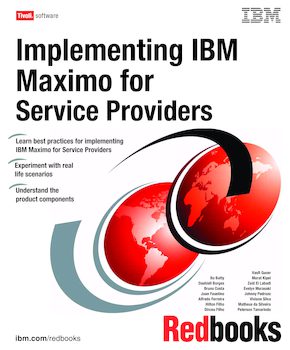Implementing IBM Maximo for Service Providers
An IBM Redbooks publication
Note: This is publication is now archived. For reference only.

Published on 23 November 2010, updated 24 November 2010
ISBN-10: 0738434841
ISBN-13: 9780738434841
IBM Form #: SG24-7891-00
Authors: Vasfi Gucer, Bo Batty, Dashiell Lucena Gonzaga Borges, Bruno Nogueira Costa, Juan Faustino, Alfredo Anselmo Oliveira Ferreira, Hilton Bertelli Ferreira Filho, Dirceu Semighini Filho, Murat Kipel, Zaid El Labadi, Evelyn Tanigawa Murasaki, Johnny Kubinhets Pedrozo, Viviane Stelina Almeida Silva, Matheus Massaru Carvalho da Silveira and Peterson Domingos Tamarindo
The IBM® Maximo® for Service Providers product is designed to support Service as a business. It helps lower total cost-of-ownership and increase profitability and customer satisfaction by managing clients' assets either through third-party outsourcing or internally shared services model.
This IBM Redbooks® publication introduces IBM Maximo for Service Providers product and its components. We took a practical approach in this book, and presented the features and functions of the IBM Maximo for Service Providers product in the context of a number of real-life scenarios or usage patterns. These scenarios are commonly used at IBM customer sites to satisfy specific business requirements. For each scenario, we establish the business reason, benefits, and how to implement the scenario. There is also a section on initial product configuration that touches on several configuration points, such as creating the customers, security groups, and response plans.
This book is a reference guide for IT Specialists and IT Architects implementing IBM Maximo for Service Providers.
Part 1. Introduction
Chapter 1. IBM Maximo for Service Providers overview
Chapter 2. Architecture and components
Chapter 3. Initial configuration
Part 2. Use cases and scenarios
Chapter 4. Service Desk scenario
Chapter 5. Assets and locations scenario
Chapter 6. Billing scenario
Chapter 7. Customer agreement scenario
Chapter 8. Migration Manager scenario
Chapter 9. Preventive maintenance scenario
Chapter 10. Security groups scenario
Chapter 11. Service level agreement (SLA) time zone scenario
Chapter 12. Pricing scenario
Chapter 13. Service Desk tickets and solutions restricted by Service Provider customers scenario